《运动解剖学》课程文献资料(脑科学)教育神经科学视域下的高中物理教学设计研究以静电场及其应用”为例
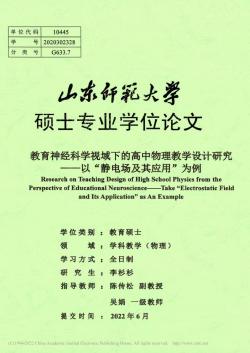
单位代码10445 学号2020302328 分类号 G633.7 山东師氟大学 硕士专业学位论文 教育神经科学视域下的高中物理教学设计研究 一一以“静电场及其应用”为例 Research on Teaching Design of High School Physics from the Perspective of Educational Neuroscience-Take"Electrostatic Field and Its Application"as An Example 学位类别:教育硕士 领域:学科教学(物理) 学习方式:全日制 研究生:李杉杉 指导教师:陈传松副教授 吴娟一级教师 提交时间:2022年6月 (C)1994-022 China Academie Joual Electronie Publishing House.All rights reserved.htp://www.enki.net
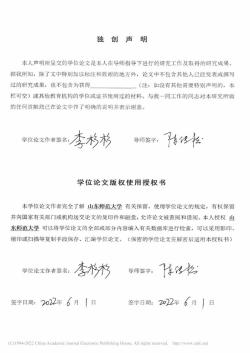
独创声明 本人声明所呈交的学位论文是本人在导师指导下进行的研究工作及取得的研究成果。 据我所知,除了文中特别加以标注和致谢的地方外,论文中不包含其他人已经发表或撰写 过的研究成果,也不包含为获得 (注:如没有其他需要特别声明的,本 栏可空)或其他教育机构的学位或证书使用过的材料。与我一同工作的同志对本研究所做 的任何贡献均已在论文中作了明确的说明并表示谢意。 学位论文作者签名 李杉 导师签字: 件公衫 学位论文版权使用授权书 本学位论文作者完全了解山东师范大学有关保留、使用学位论文的规定,有权保留 并向国家有关部门或机构送交论文的复印件和磁盘,允许论文被查阅和借阅。本人授权山 东师范大学可以将学位论文的全部或部分内容编入有关数据库进行检索,可以采用影印 缩印或扫描等复制手段保存、汇编学位论文。(保密的学位论文在解密后适用本授权书) 学位论文作者签名: 导师签字 学必格 签字日期:2022年6月|日 签字日期:2022年6月}日 (C)1994-2022 China Academic Jou ie Publishing House.All rights reserved. http://www.cnki.net

山东师范大学硕士学位论文 目录 摘要 Abstract. 第一章绪论 1.1选题背景 12选题意义」 1.3研究综述 14研究思路及目标 1.5研究方法. 第二章概念界定与理论基础 .7 2.1核心概念界定 2.1.1脑科学 .7 2.1.2教育神经科学 2.13教学设计. 7 2.1.4教育神经科学视域下的教学设计。 2.2教育神经科学的核心理论 8 2.3相关理论依据. 10 2.3.1建构主义学习理论 2.3.2情境认知理论. 2.3.3系统科学理论 第三章基于教育神经科学的教学策略构建 13 3.1帮助学生意义建构 13 3.2构建多元的学习情境。 3.3营造积极的情绪氛围 17 3.4构建及时具体的反馈机制 17 第四章“静电场及其应用”单元设计 19 4.1“静电场及其应用”单元的整体分析 .19 4.1.1课标分析 19 4.12知识结构分析 .20 (C)1994-2022 China Academie Joumal Eleetronic Publishing House.All rights reserved.http://www.enki.net
山东师范大学硕士学位论文 目 录 摘要.I Abstract . III 第一章 绪论.1 1.1 选题背景.1 1.2 选题意义.2 1.3 研究综述.2 1.4 研究思路及目标.4 1.5 研究方法.5 第二章 概念界定与理论基础.7 2.1 核心概念界定.7 2.1.1 脑科学.7 2.1.2 教育神经科学.7 2.1.3 教学设计.7 2.1.4 教育神经科学视域下的教学设计.8 2.2 教育神经科学的核心理论.8 2.3 相关理论依据.10 2.3.1 建构主义学习理论.10 2.3.2 情境认知理论.10 2.3.3 系统科学理论. 11 第三章 基于教育神经科学的教学策略构建.13 3.1 帮助学生意义建构.13 3.2 构建多元的学习情境.15 3.3 营造积极的情绪氛围.17 3.4 构建及时具体的反馈机制.17 第四章 “静电场及其应用”单元设计.19 4.1“静电场及其应用”单元的整体分析.19 4.1.1 课标分析.19 4.1.2 知识结构分析.20
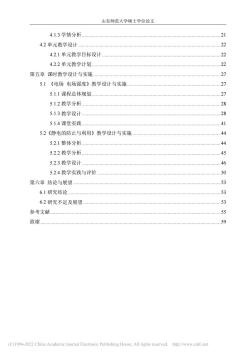
山东师范大学硕士学位论文 4.1.3学情分析 .21 42单元教学设计. .22 4.2.1单元教学目标设计 22 4.22单元教学计划 .22 第五章课时教学设计与实施 27 5.1《电场电场强度》教学设计与实施 27 5.1.1课程总体规划. .27 5.1.2教学分析 28 5.1.3教学设计 5.14课堂实践 .41 5.2《静电的防止与利用》教学设计与实施 .44 52.1整体分析 .4 52.2教学分析 5.2.3教学设计 .46 5.2.4教学实践与评价 50 第六章结论与展望 53 6.1研究结论 6.2研究不足及展望 .53 参考文献 .55 致谢. (C)1994-2022 China Academie Joumal Electronic Publishing House.All rights reserved.http://www.enki.net
山东师范大学硕士学位论文 4.1.3 学情分析.21 4.2 单元教学设计.22 4.2.1 单元教学目标设计.22 4.2.2 单元教学计划.22 第五章 课时教学设计与实施.27 5.1 《电场 电场强度》教学设计与实施.27 5.1.1 课程总体规划.27 5.1.2 教学分析.28 5.1.3 教学设计.28 5.1.4 课堂实践.41 5.2《静电的防止与利用》教学设计与实施.44 5.2.1 整体分析.44 5.2.2 教学分析.45 5.2.3 教学设计.46 5.2.4 教学实践与评价.50 第六章 结论与展望.53 6.1 研究结论.53 6.2 研究不足及展望.53 参考文献.55 致谢.59
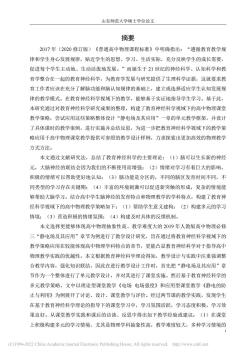
山东师范大学硕士学位论文 摘要 2017年(2020修订版)《普通高中物理课程标准》中明确指出:“遵循教育教学规 律和学生身心发展规律,贴近学生的思想、学习、生活实际,充分反映学生的成长需要, 促进每个学生主动地、生动活泼地发展。”而诞生于21世纪的神经科学、认知科学和教 育学整合在一起的教育神经科学,为教育学发展与研究提供了生理科学证据,这就要求教 育工作者应该在充分了解脑功能和脑认知规律的基础上,建立或选择适应学生认知发展规 律的教学模式。在教育神经科学视域下的教学,能够基于实证地指导学生学习。基于此, 本研究通过对教育神经科学研究成果的整理,构建了教育神经科学视域下的高中物理课堂 教学策略,尝试应用这些策略整体设计“静电场及其应用”一章的单元教学框架,并设计 了具体课时的教学案例,进行实施并总结反思,为进一步把教育神经科学视域下的教学策 略应用于高中物理课堂教学提供可参照的教学设计样例,力求探索出更加高效的物理教学 方式方法。 本文通过文献研究法,总结了教育神经科学的主要理论:(1)脑可以生长新的神经 元,大脑神经的联结会因为我们的不断使用而增强:(2)情绪对学习有着巨大的影响, 积极的情绪可以帮助更好地认知:(3)脑功能是分区的,不同的脑区发育时间不同,不 同类型的学习存在关键期:(4)丰富的环境刺激可以促进新突触的形成,复杂的情境能 够帮助大脑学习。结合高中学生脑神经的发育特点和物理教学的学科特点,构建了教育神 经科学视域下的高中物理教学策略如下:(1)帮助学生意义建构:(2)构建多元的学习 情境:(3)营造积极的情绪氛围:(4)构建及时具体的反馈机制。 本文选择更能够体现高中物理抽象性高、教学难度大的2019年人教版高中物理必修 三“静电场及其应用”章节为例进行了教学设计研究,旨在通过将教育神经科学视域下的 教学策略应用在较能体现高中物理学科特点的章节,更能凸显教育神经科学对于指导高中 物理教学实践的优越性。本文根据教育神经科学理论得知,教学设计与实践中注重强调整 合教学内容,强化知识联结,因此在进行教学设计工作时,首先把“静电场及其应用”章 节作为一个整体进行了单元教学设计,并对其进行了课堂实施。然后基于教育神经科学的 多元教学策略,文中以理论型课堂教学《电场电场强度》和应用型课堂教学《静电的防 止与利用》为例展开了讨论、设计、课堂教学与评价。经过两节课的教学实践,发现学生 在基于教育神经科学理论的指导下的课堂学习中,学习氛围活跃,学习态度积极,学习效 果良好。从课堂教学实践和课后的访谈、反思中得出如下教学经验或建议:(1)在课堂 上积极构建多元的学习情境,尤其是物理学科抽象性高,教学难度较大,多种学习情境的 C)1994-2022 China Academie Joural Electronic Publishing House.All rights reserved.http:/www.cnki.net
山东师范大学硕士学位论文 I 摘要 2017 年(2020 修订版)《普通高中物理课程标准》中明确指出:“遵循教育教学规 律和学生身心发展规律,贴近学生的思想、学习、生活实际,充分反映学生的成长需要, 促进每个学生主动地、生动活泼地发展。”而诞生于 21 世纪的神经科学、认知科学和教 育学整合在一起的教育神经科学,为教育学发展与研究提供了生理科学证据,这就要求教 育工作者应该在充分了解脑功能和脑认知规律的基础上,建立或选择适应学生认知发展规 律的教学模式。在教育神经科学视域下的教学,能够基于实证地指导学生学习。基于此, 本研究通过对教育神经科学研究成果的整理,构建了教育神经科学视域下的高中物理课堂 教学策略,尝试应用这些策略整体设计“静电场及其应用”一章的单元教学框架,并设计 了具体课时的教学案例,进行实施并总结反思,为进一步把教育神经科学视域下的教学策 略应用于高中物理课堂教学提供可参照的教学设计样例,力求探索出更加高效的物理教学 方式方法。 本文通过文献研究法,总结了教育神经科学的主要理论:(1)脑可以生长新的神经 元,大脑神经的联结会因为我们的不断使用而增强;(2)情绪对学习有着巨大的影响, 积极的情绪可以帮助更好地认知;(3)脑功能是分区的,不同的脑区发育时间不同,不 同类型的学习存在关键期;(4)丰富的环境刺激可以促进新突触的形成,复杂的情境能 够帮助大脑学习。结合高中学生脑神经的发育特点和物理教学的学科特点,构建了教育神 经科学视域下的高中物理教学策略如下:(1)帮助学生意义建构;(2)构建多元的学习 情境;(3)营造积极的情绪氛围;(4)构建及时具体的反馈机制。 本文选择更能够体现高中物理抽象性高、教学难度大的 2019 年人教版高中物理必修 三“静电场及其应用”章节为例进行了教学设计研究,旨在通过将教育神经科学视域下的 教学策略应用在较能体现高中物理学科特点的章节,更能凸显教育神经科学对于指导高中 物理教学实践的优越性。本文根据教育神经科学理论得知,教学设计与实践中注重强调整 合教学内容,强化知识联结,因此在进行教学设计工作时,首先把“静电场及其应用”章 节作为一个整体进行了单元教学设计,并对其进行了课堂实施。然后基于教育神经科学的 多元教学策略,文中以理论型课堂教学《电场 电场强度》和应用型课堂教学《静电的防 止与利用》为例展开了讨论、设计、课堂教学与评价。经过两节课的教学实践,发现学生 在基于教育神经科学理论的指导下的课堂学习中,学习氛围活跃,学习态度积极,学习效 果良好。从课堂教学实践和课后的访谈、反思中得出如下教学经验或建议:(1)在课堂 上积极构建多元的学习情境,尤其是物理学科抽象性高,教学难度较大,多种学习情境的

山东师范大学硕士学位论文 构建,可以帮助学生更加轻松地理解和掌握知识概念:(2)教师要积极备课,深入理解 教学内容,基于学生的脑认知逻辑,整合课程结构,调整教学顺序,做好教学环节衔接: (3)教师在进行教学设计时,注重新旧知识的联结,注意理论多联系生活实际,促进学 生脑神经网络更好的构建:(4)教师在课堂上要有积极向上的态度,调节课堂气氛,善 于利用幽默,给学生营造生动活泼的情绪氛围,可以大大提升学生的学习兴趣,得到更好 地教学效果;(5)要把学生放在主体地位,设计多样的教学活动,努力调动学生的多感 官参与到教学过程中,可以深化学生的脑神经网络,促进长久记忆的发生;(6)重视反 馈,注重给予学生及时的积极的反馈,努力构建集过程性评价、形成性评价和间隔性评价 于一体的多元评价体系,帮助学生形成反思自省的习惯,提升学习效果。 关键词:教育神经科学,教学策略,静电场,单元教学设计,教学建议 分类号:G633.7 (C)1994-2022 China Academie Joumal Electronic Publishing House.All rights reserved.http://www.enki.net
山东师范大学硕士学位论文 II 构建,可以帮助学生更加轻松地理解和掌握知识概念;(2)教师要积极备课,深入理解 教学内容,基于学生的脑认知逻辑,整合课程结构,调整教学顺序,做好教学环节衔接; (3)教师在进行教学设计时,注重新旧知识的联结,注意理论多联系生活实际,促进学 生脑神经网络更好的构建;(4)教师在课堂上要有积极向上的态度,调节课堂气氛,善 于利用幽默,给学生营造生动活泼的情绪氛围,可以大大提升学生的学习兴趣,得到更好 地教学效果;(5)要把学生放在主体地位,设计多样的教学活动,努力调动学生的多感 官参与到教学过程中,可以深化学生的脑神经网络,促进长久记忆的发生;(6)重视反 馈,注重给予学生及时的积极的反馈,努力构建集过程性评价、形成性评价和间隔性评价 于一体的多元评价体系,帮助学生形成反思自省的习惯,提升学习效果。 关键词:教育神经科学,教学策略,静电场,单元教学设计,教学建议 分类号:G633.7
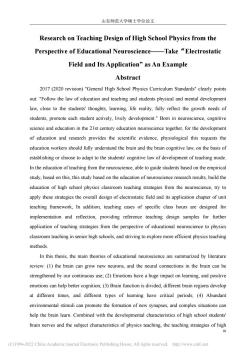
山东师范大学硕士学位论文 Research on Teaching Design of High School Physics from the Perspective of Educational Neuroscience-Take "Electrostatic Field and Its Application"as An Example Abstract 2017(2020 revision)"General High School Physics Curriculum Standards"clearly points out:"Follow the law of education and teaching and students physical and mental development law,close to the students'thoughts,learning.life reality,fully reflect the growth needs of students,promote each student actively,lively development."Bor in neuroscience,cognitive science and education in the 21st century education neuroscience together,for the development of education and research provides the scientific evidence,physiological this requests the education workers should fully understand the brain and the brain cognitive law,on the basis of establishing or choose to adapt to the students'cognitive law of development of teaching mode In the education of teaching from the neuroscience,able to guide students based on the empirical study,based on this,this study based on the education of neuroscience research results,build the education of high school physics classroom teaching strategies from the neuroscience,try to apply these strategies the overall design of electrostatic field and its application chapter of unit teaching framework,In addition,teaching cases of specific class hours are designed for implementation and reflection,providing reference teaching design samples for further application of teaching strategies from the perspective of educational neuroscience to physics classroom teaching in senior high schools,and striving to explore more efficient physics teaching methods. In this thesis,the main theories of educational neuroscience are summarized by literature review:(1)the brain can grow new neurons,and the neural connections in the brain can be strengthened by our continuous use:(2)Emotions have a huge impact on learning.and positive emotions can help better cognition,(3)Brain function is divided,different brain regions develop at different times,and different types of learning have critical periods:(4)Abundant environmental stimuli can promote the formation of new synapses,and complex situations can help the brain learn.Combined with the developmental characteristics of high school students' brain nerves and the subject characteristics of physics teaching,the teaching strategies of high (C)94-2 China Academie Joumal Electronie Publishing House.All rights reserved.http:/www.nki.et
山东师范大学硕士学位论文 III Research on Teaching Design of High School Physics from the Perspective of Educational Neuroscience——Take“Electrostatic Field and Its Application” as An Example Abstract 2017 (2020 revision) "General High School Physics Curriculum Standards" clearly points out: "Follow the law of education and teaching and students physical and mental development law, close to the students' thoughts, learning, life reality, fully reflect the growth needs of students, promote each student actively, lively development." Born in neuroscience, cognitive science and education in the 21st century education neuroscience together, for the development of education and research provides the scientific evidence, physiological this requests the education workers should fully understand the brain and the brain cognitive law, on the basis of establishing or choose to adapt to the students' cognitive law of development of teaching mode. In the education of teaching from the neuroscience, able to guide students based on the empirical study, based on this, this study based on the education of neuroscience research results, build the education of high school physics classroom teaching strategies from the neuroscience, try to apply these strategies the overall design of electrostatic field and its application chapter of unit teaching framework, In addition, teaching cases of specific class hours are designed for implementation and reflection, providing reference teaching design samples for further application of teaching strategies from the perspective of educational neuroscience to physics classroom teaching in senior high schools, and striving to explore more efficient physics teaching methods. In this thesis, the main theories of educational neuroscience are summarized by literature review: (1) the brain can grow new neurons, and the neural connections in the brain can be strengthened by our continuous use; (2) Emotions have a huge impact on learning, and positive emotions can help better cognition; (3) Brain function is divided, different brain regions develop at different times, and different types of learning have critical periods; (4) Abundant environmental stimuli can promote the formation of new synapses, and complex situations can help the brain learn. Combined with the developmental characteristics of high school students' brain nerves and the subject characteristics of physics teaching, the teaching strategies of high
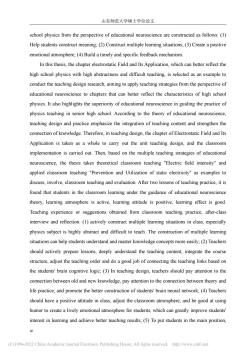
山东师范大学硕士学位论文 school physics from the perspective of educational neuroscience are constructed as follows:(1) Help students construct meaning:(2)Construct multiple learning situations;(3)Create a positive emotional atmosphere:(4)Build a timely and specific feedback mechanism. In this thesis,the chapter electrostatic Field and Its Application,which can better reflect the high school physics with high abstractness and difficult teaching.is selected as an example to conduct the teaching design research,aiming to apply teaching strategies from the perspective of educational neuroscience to chapters that can better reflect the characteristics of high school physics.It also highlights the superiority of educational neuroscience in guiding the practice of physics teaching in senior high school.According to the theory of educational neuroscience, teaching design and practice emphasize the integration of teaching content and strengthen the connection of knowledge.Therefore,in teaching design,the chapter of Electrostatic Field and Its Application is taken as a whole to carry out the unit teaching design,and the classroom implementation is carried out.Then,based on the multiple teaching strategies of educational neuroscience,the thesis takes theoretical classroom teaching "Electric field intensity"and applied classroom teaching "Prevention and Utilization of static electricity"as examples to discuss,involve,classroom teaching and evaluation.After two lessons of teaching practice,it is found that students in the classroom learning under the guidance of educational neuroscience theory.learning atmosphere is active,learning attitude is positive.learning effect is good. Teaching experience or suggestions obtained from classroom teaching practice,after-class interview and reflection:(1)actively construct multiple learning situations in class,especially physics subject is highly abstract and difficult to teach.The construction of multiple learning situations can help students understand and master knowledge concepts more easily:(2)Teachers should actively prepare lessons,deeply understand the teaching content,integrate the course structure,adjust the teaching order and do a good job of connecting the teaching links based on the students brain cognitive logic,(3)In teaching design,teachers should pay attention to the connection between old and new knowledge.pay attention to the connection between theory and life practice,and promote the better construction of students'brain neural network;(4)Teachers should have a positive attitude in class,adjust the classroom atmosphere,and be good at using humor to create a lively emotional atmosphere for students,which can greatly improve students' interest in learning and achieve better teaching results:(5)To put students in the main position, C)1994-022 China Academie Joural Electronic Publishing House.All rights reserved.http://www.enki.net
山东师范大学硕士学位论文 IV school physics from the perspective of educational neuroscience are constructed as follows: (1) Help students construct meaning; (2) Construct multiple learning situations; (3) Create a positive emotional atmosphere; (4) Build a timely and specific feedback mechanism. In this thesis, the chapter electrostatic Field and Its Application, which can better reflect the high school physics with high abstractness and difficult teaching, is selected as an example to conduct the teaching design research, aiming to apply teaching strategies from the perspective of educational neuroscience to chapters that can better reflect the characteristics of high school physics. It also highlights the superiority of educational neuroscience in guiding the practice of physics teaching in senior high school. According to the theory of educational neuroscience, teaching design and practice emphasize the integration of teaching content and strengthen the connection of knowledge. Therefore, in teaching design, the chapter of Electrostatic Field and Its Application is taken as a whole to carry out the unit teaching design, and the classroom implementation is carried out. Then, based on the multiple teaching strategies of educational neuroscience, the thesis takes theoretical classroom teaching "Electric field intensity" and applied classroom teaching "Prevention and Utilization of static electricity" as examples to discuss, involve, classroom teaching and evaluation. After two lessons of teaching practice, it is found that students in the classroom learning under the guidance of educational neuroscience theory, learning atmosphere is active, learning attitude is positive, learning effect is good. Teaching experience or suggestions obtained from classroom teaching practice, after-class interview and reflection: (1) actively construct multiple learning situations in class, especially physics subject is highly abstract and difficult to teach. The construction of multiple learning situations can help students understand and master knowledge concepts more easily; (2) Teachers should actively prepare lessons, deeply understand the teaching content, integrate the course structure, adjust the teaching order and do a good job of connecting the teaching links based on the students' brain cognitive logic; (3) In teaching design, teachers should pay attention to the connection between old and new knowledge, pay attention to the connection between theory and life practice, and promote the better construction of students' brain neural network; (4) Teachers should have a positive attitude in class, adjust the classroom atmosphere, and be good at using humor to create a lively emotional atmosphere for students, which can greatly improve students' interest in learning and achieve better teaching results; (5) To put students in the main position

山东师范大学硕士学位论文 design a variety of teaching activities,and strive to mobilize students'multi-sensory participation in the teaching process.can deepen the students'brain neural network,promote the occurrence of long-term memory;(6)Attach importance to feedback,pay attention to give students timely and positive feedback,strive to build a multi-evaluation system integrating process evaluation, formative evaluation and interval evaluation,help students form the habit of introspection, improve the learning effect. Key words:educational neuroscience.teaching strategies,electrostatic fields,unit instructional design,instructional suggestions Classification:G633.7 (C)1994-022 China Academie Journal Electronic Publishing House.All rights reserved.http://www.enki.net
山东师范大学硕士学位论文 V design a variety of teaching activities, and strive to mobilize students' multi-sensory participation in the teaching process, can deepen the students' brain neural network, promote the occurrence of long-term memory; (6) Attach importance to feedback, pay attention to give students timely and positive feedback, strive to build a multi-evaluation system integrating process evaluation, formative evaluation and interval evaluation, help students form the habit of introspection, improve the learning effect. Key words: educational neuroscience, teaching strategies, electrostatic fields, unit instructional design, instructional suggestions Classification: G633.7
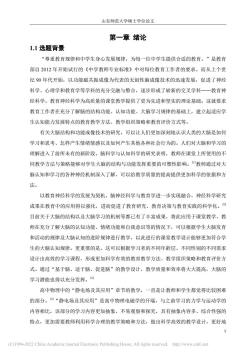
山东师范大学硕士学位论文 第一章绪论 1.1选题背景 “尊重教育规律和中学生身心发展规律,为每一位中学生提供合适的教育。”是教育 部自2012年开始试行的《中学教师专业标准》中对每位教育工作者的要求。而从上个世 纪90年代开始,以功能磁共振成像为代表的无创性脑成像技术的迅速发展,促进了神经 科学、心理学和教育学等学科的充分交融与整合,逐步形成了崭新的交叉学科一一教育神 经科学。教育神经科学为高质量的课堂教学提供了更为先进和坚实的理论基础。这就要求 教育工作者在充分了解脑的结构功能、认知功能、大脑学习规律的基础上,建立起适应学 生认知能力发展特点的教育教学方法、教学组织策略和教育评价方式等 有关大脑结构和功能成像技术的研究,可以让人们更加深刻地认识人类的大脑是如何 学习和思考、怎样产生情绪情感以及如何产生其他各种社会行为的。人们对大脑和学习的 理解进入了前所未有的新阶段。脑科学与认知科学的研究表明,教师在课堂上所使用的不 同教学方法与策略能够对学生大脑的结构与功能发挥重要的可塑性影响。教师通过对大 脑认知和学习的各种神经机制深入了解,可以给教学质量的提高提供更加科学的依据和方 法。 以教育神经科学的发展为契机,脑神经科学与教育学进一步实现融合,神经科学研究 成果在教育中的应用得以强化,进而促进了教育研究、教育决策与教育实践的科学化。回 目前关于大脑的结构以及大脑学习的机制等都已有了丰富成果,将此应用于课堂教学,教 师在充分了解大脑的认知功能、情绪功能和自我意识等的情况下,可以根据学生大脑发育 和活动的规律及大脑认知的进阶规律进行教学,以此进行的课堂教学设计能够更加符合学 生的大脑认知规律。更重要的是,这可以根据学习者的不同年龄层、不同性别的不同需求 设计出高效的学习课程,形成更加科学有效的教育教学方法、教学组织策略和教育评价方 式。通过“基于脑、适于脑、促进脑”的教学设计,教学质量和效率将大大提高,大脑的 学习潜能也得以充分发挥。 高中物理中的“静电场及其应用”章节的教学,一直是让教师和学生都觉得比较困难 的部分。0“静电场及其应用”是高中物理电磁学的开端,与之前学习的力学与运动学的 内容相比,该部分的学习内容更加抽象,不易观察和探究,具有抽象内容多、综合性强的 特点,更加需要教师利用科学合理的教学策略和方法,做出科学高效的教学设计,更好地 1 (C)1994-02 China Academie Joumal Eleetronic Publishing House.All rights reserved.http://www.enki.net
山东师范大学硕士学位论文 1 第一章 绪论 1.1 选题背景 “尊重教育规律和中学生身心发展规律,为每一位中学生提供合适的教育。”是教育 部自 2012 年开始试行的《中学教师专业标准》中对每位教育工作者的要求。而从上个世 纪 90 年代开始,以功能磁共振成像为代表的无创性脑成像技术的迅速发展,促进了神经 科学、心理学和教育学等学科的充分交融与整合,逐步形成了崭新的交叉学科——教育神 经科学。教育神经科学为高质量的课堂教学提供了更为先进和坚实的理论基础。这就要求 教育工作者在充分了解脑的结构功能、认知功能、大脑学习规律的基础上,建立起适应学 生认知能力发展特点的教育教学方法、教学组织策略和教育评价方式等。 有关大脑结构和功能成像技术的研究,可以让人们更加深刻地认识人类的大脑是如何 学习和思考、怎样产生情绪情感以及如何产生其他各种社会行为的。人们对大脑和学习的 理解进入了前所未有的新阶段。脑科学与认知科学的研究表明,教师在课堂上所使用的不 同教学方法与策略能够对学生大脑的结构与功能发挥重要的可塑性影响。 [1]教师通过对大 脑认知和学习的各种神经机制深入了解,可以给教学质量的提高提供更加科学的依据和方 法。 以教育神经科学的发展为契机,脑神经科学与教育学进一步实现融合,神经科学研究 成果在教育中的应用得以强化,进而促进了教育研究、教育决策与教育实践的科学化。 [2] 目前关于大脑的结构以及大脑学习的机制等都已有了丰富成果,将此应用于课堂教学,教 师在充分了解大脑的认知功能、情绪功能和自我意识等的情况下,可以根据学生大脑发育 和活动的规律及大脑认知的进阶规律进行教学,以此进行的课堂教学设计能够更加符合学 生的大脑认知规律。更重要的是,这可以根据学习者的不同年龄层、不同性别的不同需求 设计出高效的学习课程,形成更加科学有效的教育教学方法、教学组织策略和教育评价方 式。通过“基于脑、适于脑、促进脑”的教学设计,教学质量和效率将大大提高,大脑的 学习潜能也得以充分发挥。[3] 高中物理中的“静电场及其应用”章节的教学,一直是让教师和学生都觉得比较困难 的部分。[4]“静电场及其应用”是高中物理电磁学的开端,与之前学习的力学与运动学的 内容相比,该部分的学习内容更加抽象,不易观察和探究,具有抽象内容多、综合性强的 特点,更加需要教师利用科学合理的教学策略和方法,做出科学高效的教学设计,更好地
按次数下载不扣除下载券;
注册用户24小时内重复下载只扣除一次;
顺序:VIP每日次数-->可用次数-->下载券;
- 《运动解剖学》课程文献资料(脑科学)教育文化视域下学习科学的研究趋势_李凤营.pdf
- 《运动解剖学》课程文献资料(脑科学)建筑的神经科学研究——缘起、内容与工具_周祥.pdf
- 《运动解剖学》课程文献资料(脑科学)基于项目式学习的科学教育领域跨学科概念建构.pdf
- 《运动解剖学》课程文献资料(脑科学)基于项目化学习培养科学思维能力的实践研究以高中生物学探究实验为例.pdf
- 《运动解剖学》课程文献资料(脑科学)基于脑科学的微课教学设计探索.pdf
- 《运动解剖学》课程文献资料(脑科学)基于翻转课堂的小学科学项目式学习活动设计研究.pdf
- 《运动解剖学》课程文献资料(脑科学)基于突触可塑性的复杂系统中信息传输机制的研究.pdf
- 《运动解剖学》课程文献资料(脑科学)基于科学探究能力发展的项目式学习在中学生物学教学中的实践研究.pdf
- 《运动解剖学》课程文献资料(脑科学)基于科创竞赛的科学教育:学习环境、学习过程与培养效果.pdf
- 《运动解剖学》课程文献资料(脑科学)基于神经科学的道德认知研究_艾鹏.pdf
- 《运动解剖学》课程文献资料(脑科学)基于混合式教学的中医内科学学习策略探究_于鹏龙.pdf
- 《运动解剖学》课程文献资料(脑科学)基于混合学习的生物科学专业学生学习风格研究以唐山师范学院为例.pdf
- 《运动解剖学》课程文献资料(脑科学)基于学本评估”理论的混合学习评价活动设计研究.pdf
- 《运动解剖学》课程文献资料(脑科学)基于学习科学的“以学为中心”教学研究与实践_刘庆华.pdf
- 《运动解剖学》课程文献资料(脑科学)后疫情时代人类学习的未来趋向系统科学的哲学思考.pdf
- 《运动解剖学》课程文献资料(脑科学)创新思维的脑生理、心理协同发生机制探析.pdf
- 《运动解剖学》课程文献资料(脑科学)共同富裕视域下分配公平对幸福感的影响因果推断与机器学习在社会科学中的融合应用.pdf
- 《运动解剖学》课程文献资料(脑科学)从脑科学诠释体育运动提升学习效益的理论与实践_周成林.pdf
- 《运动解剖学》课程文献资料(脑科学)从STEM到STEAM脑科学基础及教育启示.pdf
- 《运动解剖学》课程文献资料(脑科学)《非常规教学法:脑科学实用观促进学习》(第三、四章)翻译实践报告.pdf
- 《运动解剖学》课程文献资料(脑科学)教育神经科学视角下小学汉字学习的教学设计与运用.pdf
- 《运动解剖学》课程文献资料(脑科学)核心素养视域下小学科学学习活动设计思路及模型搭建.pdf
- 《运动解剖学》课程文献资料(脑科学)混合学习环境下高校课堂论证式教学研究.pdf
- 《运动解剖学》课程文献资料(脑科学)焦虑的脑科学研究与临床应用进展.pdf
- 《运动解剖学》课程文献资料(脑科学)结合脑科学的生物学学科核心素养培养策略.pdf
- 《运动解剖学》课程文献资料(脑科学)脑科学与五育融合:劳动教育的审美功能.pdf
- 《运动解剖学》课程文献资料(脑科学)跨学科开启头脑风暴_促进脑科学交叉与融合_蒲慕明.pdf
- 《运动解剖学》课程教学资源(文献资料)基于肌肉激活度的关节运动角度分层预测.pdf
- 《运动解剖学》课程教学资源(文献资料)身体功能训练在肩关节运动功能恢复中的应用研究——以优秀男子举重运动员SLAP损伤个案为例.pdf
- 《运动解剖学》课程教学资源(文献资料)运动干预对髌股关节疼痛综合征的康复效果研究.pdf
- 《运动解剖学》课程教学资源(文献资料)经颅直流电刺激对肘关节等动运动中力量输出、肌肉活性的影响.pdf
- 长春中医药大学:《中医护理学基础》课程教学实训指导(针刺法、灸法、拔罐法).pdf
- 长春中医药大学:《中医护理学基础》课程教学课件(PPT讲稿)切诊.ppt
- 长春中医药大学:《中医护理学基础》课程教学课件(PPT讲稿)闻诊.ppt
- 长春中医药大学:《中医护理学基础》课程教学课件(PPT讲稿)问诊.ppt
- 长春中医药大学:《中医护理学基础》课程教学课件(PPT讲稿)望诊.ppt
- 长春中医药大学:《中医护理学基础》课程教学课件(PPT讲稿)八纲辨证施护.ppt
- 长春中医药大学:《中医护理学基础》课程教学课件(PPT讲稿)气血津液辨证.ppt
- 长春中医药大学:《中医护理学基础》课程教学课件(PPT讲稿)卫气营血辨证.ppt
- 长春中医药大学:《中医护理学基础》课程教学课件(PPT讲稿)肝与胆病的辨证施护.ppt
